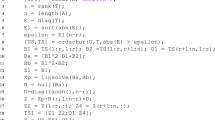Summary
A method to generate an accurate approximation to a singular solution of a system of complex analytic equations is presented. Since manyreal systems extend naturally tocomplex analytic systems, this porvides a method for generating approximations to singular solutions to real systems. Examples include systems of polynomials and systems made up of trigonometric, exponential, and polynomial terms. The theorem on which the method is based is proven using results from several complex variables. No special conditions on the derivatives of the system, such as restrictions on the rank of the Jacobian matrix at the solution, are required. The numerical method itself is developed from techniques of homotopy continuation and 1-dimensional quadrature. A specific implementation is given, and the results of numerical experiments in solving five test problems are presented.
Similar content being viewed by others
References
Allgower, E.L.: A survey of homotopy methods for smooth mappings. In: Allgower, E.L., Glashoff, K., Peitgen, H.-O. (eds.) Numerical solution of nonlinear equations. Lect. Notes Math. Vol. 878, pp. 1–29. Berlin Heidelberg New York: Springer 1981
Allgower, E.L., Georg, K.: Simplicial and continuation methods for approximating fixed points and solutions to systems of equations. SIAM Rev.22, 28–85 (1980)
Chow, S.N., Mallet-Paret, J., Yorke, J.A.: Finding zeros of maps: Homotopy methods that are constructive with probability one. Math. Comput.32, 887–899 (1978)
Decker, D.W., Kelley, C.T.: Newton's method at singular points. I. SIAM J. Numer. Anal.17, 66–70 (1980)
Decker, D.W., Kelley, C.T.: Newton's method at singular points. II. SIAM J. Numer. Anal.17, 465–471 (1980)
Decker, D.W., Kelley, C.T.: Broyden's method for a class of problems having singular Jacobian at the root. SIAM J. Numer. Anal.22, 566–574 (1985)
Fischer, G.: Complex analytic geometry. Lect. Notes Math. Vol. 538. Berlin Heidelberg New York: Springer 1977
Garcia, C.B., Zangwill, W.I.: Pathways to solutions, fixed points, and equilibria. First Ed. Englewood Cliffs, N.J.: Prentice-Hall 1981
Griewank, A.: On solving nonlinear equations with simple singularities or nearly singular solutions. SIAM Rev.27, 537–563 (1985)
Griewank, A., Osborne, M.R.: Analysis of Newton's method at irregular singularities. SIAM J. Numer. Anal.20, 747–773 (1983)
Griffiths, P., Harris, J.: Principles of algebraic geometry. First Ed. New York: Wiley 1978
Guillemin, V., Pollack, A.: Differential topology, First Ed. Englewood Cliffs, NY. Prentice-Hall 1981
Gunning, R., Rossi, H.: Analytic functions of several complex Variables. First Ed. Englewood Cliffs, N.J.: Prentice Hall 1965
Incerti, S., Zirilli, F., Parisi, V.: A FORTRAN subroutine for solving systems of nonlinear simultaneous equations. Comput.24, 87–91 (1981)
Morgan, A.P.: Solving polynomial systems using continuation for scientific and engineering problems, First Ed. Englewood Cliffs, N.J.: Prentice-Hall 1987
Morgan, A.P., Sommese, A.J.: A homotopy for solving general polynomial systems that respectsm-homogeneous structures. Appl. Math. Comput.24, 101–113 (1987)
Morgan, A.P., Sommese, A.J.: Computing all solutions to polynomial systems using homotopy continuation. Appl. Math. Comput.24, 115–138 (1987)
Morgan, A.P., Sommese, A.J.: Coefficient-parameter polynomial continuation. Appl. Math. Comput.29, 123–160 (1989)
Morgan, A.P., Sommese, A.J.: Generically nonsingular polynomial continuation. In: Computational solution of nonlinear systems of equations. AMS Lectures in Appl. Math., Vol. 26, Allgower, E., Georg, K. (eds.), American Mathematical Society 1990
Morgan, A.P., Sommese, A.J., Wampler, C.W.: Polynomial continuation for mechanism design problems. In: Computational solution of nonlinear systems of equations. AMS Lect. Appl. Math., Vol. 26, Allgower, E., Georg, K. (eds.), American Mathematical Society 1990
Rall, L.B.: Convergence of the Newton process to multiple solutions. Numer. Math.9, 23–37 (1966)
Reddien, G.W.: On Newton's method for singular problems. SIAM J. Numer. Anal.15, 993–996 (1978)
Rheinboldt, W.C.: Numerical analysis of parameetrized nonlinear equations, First Ed. New York: John Wiley 1986
Rheinboldt, W.C., Burkardt, J.V.: Algorithm 596: A program for a locally parameterized continuation process. ACM Trans. Math. Software9, 236–241 (1983)
Wampler, C.W., Morgan, A.P., Sommese, A.J.: Numerical continuation methods for solving polynomial systems arising in kinematics. ASME J. Design112, 59–68 (1990)
Watson, L.T.: A globally convergent algorithm for computing fixed points ofC 2 maps. Appl. Math. Comput.5, 297–311 (1979)
Watson, L.T., Billups, S.C., Morgan, A.P.: HOMPACK: A suite of codes for globally convergent homotopy algorithms. ACM Trans. Math. Software13, 281–310 (1987)
Author information
Authors and Affiliations
Rights and permissions
About this article
Cite this article
Morgan, A.P., Sommese, A.J. & Wampler, C.W. Computing singular solutions to nonlinear analytic systems. Numer. Math. 58, 669–684 (1990). https://doi.org/10.1007/BF01385648
Received:
Issue Date:
DOI: https://doi.org/10.1007/BF01385648




